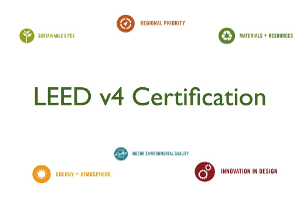What Building Product Reps Don’t Know About LEED v4
- < How CSI Helps Manufacturers Get Their Building Products Specified
- > Pay Attention: You Either Got Your Product Specified or You Didn’t
The LEED Rating system has been around for twenty years. In 2013, the latest rating system LEED v4 was launched. Yet, many building product reps are completely in the dark when it comes to LEED and the specification opportunities it offers. Most manufacturers have a LEED point person to handle LEED and sustainability related questions. Larger corporations might have a Director of Sustainability to handle the day to day questions about LEED, product disclosures, testing, and technical assistance.
The Good News!
Building product manufacturers have multiple opportunities to get specified on LEED v4 projects. In the fourth quarter of 2017, over 682 projects were LEED certified for commercial projects in the United States. LEED is not going away. In a previous blog, we discussed that the construction industry added over 210,000 jobs in 2017, a 35 percent increase over 2016. Private construction projects have been especially strong. So, how can building product manufacturers leverage LEED v4 to get specified?
Building product reps don’t need to be experts on LEED. In fact, most product reps only know the LEED credits that apply to their individual products. However, it is helpful for all AEC professionals to have a broad understanding of LEED and how it can benefit their projects. There have been major changes made to the LEED v4 rating system compared to previous versions, including an overhaul of how building products can contribute. Selecting “preferable” building materials, those with desirable human health and environmental are a significant component of LEED.
LEED Myths and Misinformation
There are several opportunities for product manufacturers to get specified in LEED v4 and maximize their ROI. However, there are several myths and misinformation in the marketplace about LEED v4. This misinformation can frustrate manufacturers and make participating in a LEED project seem impossible. Let’s review and refute several myths about LEED v4.
- USGBC certifies products. You can get a LEED certified product. False! The USGBC does not certify or endorse building products. Anyone who says they have a LEED certified product is misinformed or lying.
- LEED bans certain products. False! LEED does not prohibit any building products. LEED sets optional performance/environmental based requirements that need to be achieved to earn points (like for FSC lumber) however LEED does not ban products like PVC.
- Manufacturers are excluded from LEED process. False! Manufacturers make up a significant amount of membership and the annual GreenBuild show would cease to exist without manufacturers. Manufacturers are crucial for LEED and they can benefit from being involved.
How to Get Specified On LEED Projects
Building product reps can get specified on LEED projects via multiple strategies. If you are new to LEED v4, the best strategy is to pursue the low-hanging fruit. Manufacturers can contribute to several LEED credits in the Materials and Resources (MR) category and Indoor Environmental Quality (IEQ) category for New Construction BD+C projects. Companies wanting to utilize their budget dollars to maximize ROI should review these strategies first.
LEED Product Documentation
Before a product manufacturer can get specified on a LEED project, they need to know how they can contribute per LEED credit category. Architects, specifiers, interior designers, engineers, and contractors need to know how your product contributes to LEED. LEED product documentation is a necessity for your website, brochures, tradeshow hand-outs, etc. All product reps should have a breakdown of how your product contributes, credit by credit to LEED.

Health Product Declaration
The Health Product Declaration (HPD) is one of the most requested product transparency documents for LEED v4. Major firms in the U.S. are requesting HPDs from manufacturers. AEC firms such as Perkins + Will, Smith Group JJR, HKS, and ZGF are all encouraging building product manufacturers to provide HPDs to be considered for product specification. Product manufacturers who offer HPDs will be given preference over manufacturers that don't comply with these requests.
The good news for manufacturers is that HPDs are one of the easiest and most cost-effective ways to participate in LEED v4, the Living Building Challenge (LBC), WELL Building projects, Google Portico, and the mindful MATERIALS database. Every product manufacturer on the planet can contribute points to LEED v4 projects with a LEED compliant HPD. Product manufacturers with a LEED compliant HPD can contribute points under the credit LEEDv4 BD+C Building Product Disclosure and Optimization- material ingredients.
Some product manufacturers are under the false impression that they can’t develop a LEED complaint HPD because their product contains potential hazards, toxins, cancer causing chemicals, etc. This is false. All LEED compliant HPDs can fulfill the requirements for Option 1 of this credit since it is simply a disclosure tool. Your product could have asbestos, mercury, cadmium, and radioactive sludge and still be eligible for a point. Of course, the architect might not want their occupants to glow green and look like zombies but hypothetically speaking, an HPD for asbestos could still earn one point!
LEED Resources for Building Product Reps
Luckily, there are multiple no-cost resources for building product reps to learn about LEED. A Free LEED Exam Prep course is available for professionals wanting an overview of LEED v4 or to take the LEED Green Associate Exam. In addition, there is a one hour free course Get Savvy: LEED v4 for Product Manufacturers which educates manufacturers about specification opportunities in LEED v4. Finally, we encourage all building product reps to join their local USGBC chapter to stay educated about LEED, network, and be an industry advocate for sustainability.
The Future
USGBC will launch LEED v4.1 within the next 12 months. According to the USGBC, ““LEED v4.1 will use the existing credit requirements as a foundation for new strategies and technologies.” It will not be a major overhaul of the rating system but offer modifications, many of which will probably benefit product manufacturers. Overall, there are many ways building product reps can be involved in the LEED process and several free resources to help them.
How does your company train product reps about LEED? What strategies does your organization use to get your products specified for LEED projects?
For more information or to discuss the topic of this blog, please contact Brad Blank





